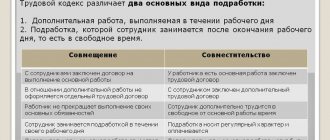Motivation: meaning and goals
Work motivation is understood as organizing the company’s work in such a way that everyone tries to perform their professional duties in the best possible way and “give their best.” In other words, each employee receives an internal incentive that increases productivity and is aimed at achieving a common goal.
Often, the company's administration acts in the old fashioned way: rewards the best, punishes the worst, and holds annual corporate parties for everyone. But this scheme does not always work. It is unlikely that you will want to go to a corporate event if the work environment is depressing every day.
Competently stimulating staff requires the manager to know basic motivation methods. A subordinate whose contribution to the overall achievement was not noticed or appreciated will not want to “prove himself” in the future.
Everyone needs praise: a newcomer who finds it difficult to “fit in” to the team, and a strict careerist who, under the dry mask of responsibility and devotion to the company, hides the desire to hear praise addressed to him or get additional leave.
The head of the organization develops his own individual motivation scheme for subordinate employees.
Motivation is the creation of internal factors that motivate you to do work. Motivation can be controlled from the outside, using stimulation techniques.
What is staff motivation?
The term “motivation” in a general sense is explained as a set of incentives that influence the action of a particular person. Based on this, staff motivation is a set of incentives that the manager uses to achieve maximum employee performance.
Each company and each manager has its own method of motivating work and favorite methods of motivation. The set of methods used in the company is the system of personnel motivation. The process of motivation and its planning is not as simple as it seems at first glance. You cannot thoughtlessly reward, encourage, or give out “goodies” to employees, otherwise you risk not improving the quality of work, but sabotaging the process.
Principles of Motivation
There is no single rule or way to motivate staff, but there are principles for developing your own effective method:
1. Motivation that allows the employee to feel important and needed will be effective. Such encouragement evokes respect and good envy among colleagues. However, you should know when to stop everything, otherwise the loss of awards will lead to the moral disqualification of the employee.
2. Unforeseen one-time incentives work more successfully than systemic incentives (monthly bonuses for high-quality work). People quickly get used to systematic methods and consider them part of the norm.
3. Praise works better than punishment.
4. Management's reaction (positive or negative) must be immediate. Thus, the subordinate feels significant: the boss is not indifferent to his achievements or failures.
5. An intermediate result is also a result! Incentivizing employees for small successes will speed up the achievement of the main goal.
Herzberg's theory of motivation
Herzberg's motivation theory or two-factor theory states that there are two factors that an organization can adjust to in order to influence motivation levels in the workplace.
Herzberg identified two factors:
- Motivating factors . Having motivating factors encourages employees to work harder. These are factors in the workplace.
- Hygiene factors . Hygiene factor, if absent, will hinder employees from doing their best at work. Hygiene factors are environmental factors that contribute to employee behavior.
Here are some examples of motivating and hygiene factors.
| Motivating factors | Hygiene factors |
| Confession | Safety |
| Height | Company policy |
| Achievements | Salary |
| The work itself | Working conditions |
| Responsibility | Manager/supervisor |
There are 4 statistics involved here:
High hygiene and high motivation
This is the ideal situation that any manager or leader would like to achieve. Here all employees are well motivated and there are very few grievances.
High hygiene and low motivation
In this situation, employees have very few complaints, but they are also not highly motivated. A very good example of this situation: employees are paid well, but the work is not very interesting. Employees simply take their paychecks and leave.
Low hygiene and high motivation
This is a difficult question, the employees here are very motivated, but they have many grievances. A typical example of this situation is when the work is extremely interesting, but the workers are not paid according to market standards.
Low hygiene and low motivation
There's no point in guessing, this is clearly a bad situation. There is no employee motivation or compliance with hygiene requirements.
Motivation: theory and practice
Popular methods of motivating staff are developed on the basis of motivation theories. There are four in total:
- Herzberg's theory.
- Taylor's theory.
- McClelland's theory.
- Maslow's theory.
Herzberg's theory
Herzberg suggests using external and internal methods to improve the performance of an enterprise. External methods involve creating comfortable working conditions, and internal methods involve creating employee satisfaction from working in the organization.
Taylor theory
Taylor advises using subordinates' instincts and desires to satisfy physiological needs to stimulate them. He suggests using the following methods:
- payment depending on output or work time;
- pressure;
- establishing minimum production standards;
- clear rules for performing functional duties.
McClelland's theory
McClelland puts forward a theory about the types of human desires:
- power;
- success;
- belonging to a particular caste.
The majority of employees are glad to be in the ranks of a certain company and value their status. Leaders try to gain power, and loners work for personal results. If you conditionally divide employees into three categories, it is easy to find an approach to each.
Maslow's theory
Maslow suggests viewing work as an opportunity for staff to satisfy their needs. Maslow considers all needs in the form of a hierarchy (pyramid). He shares:
- Physiological needs: food, water. Everything you need to survive.
- Security: A sense of security is necessary to maintain a certain standard of living.
- Love: the desire to be liked by colleagues.
- Recognition: a person wants to have a certain status in the team and society as a whole.
- Self improvement.
motivation and its types
It is precisely because of the misconception that employee motivation lies only in money that I want to give it the correct definition and convey the correct understanding.
Motivating staff is a way to increase productivity. This is speaking in dry scientific language. Speaking to normal people:
Personnel motivation is the creation of conditions and various incentives in the company that encourage employees to work more efficiently and better in achieving their goals.
However, before we begin to consider the types and forms of motivation, let's understand how it affects the staff themselves. What kind of goodies she gives, and how much attention she needs to pay.
So, the positive results of introducing work motivation:
- Encourages employees to better perform their job duties;
- Increases the efficiency of their work and the productivity of the company as a whole;
- Creates a favorable mood in the team;
- Promotes long-term employee retention (thereby reducing turnover and personnel costs);
- Creating a staff of qualified employees who value their work;
- Increases employee loyalty to the company they work for;
- Creates a corporate culture.
It turns out that if you know the types of work motivation, correctly use the forms and levels of motivation, then it can help in the development of the company and leave competitors far behind.
And, of course, create a dream team. And not such “losers” as in this excerpt from the film:
After reading the information above, you may decide that in this article I am only trying to create a convenient place to work.
But this is not so, everything should be in moderation. To begin with, I wanted to show that the essence and types of motivation can be different, and not everything is tied to money.
I would also like to draw your attention to the fact that in life there are a lot of different theories of motivation - Maslow, McGregor, Vroom, Adams, etc.
I’ll tell you honestly, all this, of course, is good and worthy of respect. But this needs to be done when you have a company of more than 300 people. And up to this amount, it is enough for you to know the main types of work motivation. There are two main types:
- Material;
- Intangible.
Intangible is divided into two more types:
- Social;
- Psychological.
Why should you use more than just money in motivation? Isn't that what everyone comes to work for? After all, it is much easier to pay a person for his work, and everyone will be happy.
But that's not true. All people are stimulated by different things. For some it’s money, for others it’s just a simple friendly pat on the shoulder. Therefore, various types of motivation and incentives for personnel were invented.
For example, when working with sellers or sales managers after adaptation, we conduct a Gerchikov test to find out what type of work motivation a particular employee belongs to, and what kind of motivation should be applied specifically to him.
By the way. I advise you to run your employees through this test - zdorovie-seti.moy.su/test_trudovaja_motivacija.pdf. Or maybe you are forcing a person to sell who is not at all interested in money.
We will analyze the methods and methods of motivation separately, but on my own behalf I would like to add in advance that it is necessary to motivate staff COMPLEXLY, that is, there must also be non-material motivation of employees, along with money. Or a very small difference.
WE ARE ALREADY MORE THAN 32,000 people. TURN ON
In-scale / marketing
Economic (material) incentives
One of the most popular types of enhancing the performance of enterprise employees. A competent approach to remuneration increases labor productivity.
Economic motivation of personnel is divided into two subtypes: monetary and non-monetary.
Monetary incentives are:
- additional payments for high performance indicators: bonuses, bonuses, interest on transactions, salary increases;
- encouraging a healthy lifestyle. Bonuses for no sick leave, incentives for non-smokers, payment for gym memberships;
- payment of health and social insurance;
- increased pay for hazardous working conditions if they cannot be improved;
- provision, in addition to the annual leave provided for by the Labor Code, additional rest time (for family reasons, in connection with a wedding, study);
- cash payments for a birthday, wedding, anniversary, in emergency situations (death of loved ones, robbery, fire);
- compensation of employee expenses for travel to the enterprise or organization of official transport;
- pension benefits. Special compensation payments from the organization to reward deserving retired employees.
Non-monetary type of economic incentives:
- the presence of social institutions of the enterprise;
- free or partially paid vouchers for employees and their family members to sanatoriums or recreation centers;
- preferential terms for purchasing the organization's products;
- remuneration when changing jobs;
- improvement of working conditions and material and technical equipment;
- flexible schedule for performing professional duties;
- shortened working day or week;
- free tickets to concerts, theaters, cinemas;
Particular attention should be paid to the allocation of funds for corporate holidays. Carrying out such events helps to unite colleagues, instill a corporate spirit in the staff, and establish friendly relations between employees.
Material motivation
As a rule, financial motivation of staff is the most frequently used in companies.
As I already wrote, by material motivation of employees, most managers mean bonuses or fines. However, there are different types of material motivation, there are 3 of them.
Type 1. Cash reward
Most likely, you are familiar with the “pay for results” system. This is our monetary motivation.
Research has long shown that “pay for performance” is the most effective way to motivate employees. It works like this:
The employee has KPIs that he must achieve and a list of tasks that he must complete. For this he receives a monetary reward. This is monetary motivation, which includes:
- Salary, including its increase;
- Percentage of sales (the most common approach);
- Bonuses, premiums, allowances;
- Insurance, social packages;
- Reward for the winner of the competition for staff.
Examples:
- The employee who sells the highest amount in a month receives a prize of 5-10 thousand rubles;
- If the plan is fulfilled by 110%, the sales manager receives 3,000 bonuses;
- When the sales plan is achieved from 70 to 80%, the employee’s percentage of sales is 5%, and when the plan is fulfilled from 80 to 90%, his percentage becomes 8%.
You need to encourage employees, and do it from different angles. And even if you pay 500,000 rubles a month, you need to do this for different reasons.
Otherwise, the person will lose interest, and he will consider it your duty.
For more details on how to structure the monetary component correctly, read our article.
On the topic: Motivating sales managers: examples of schemes that you will definitely want to implement.
Type 2. Non-monetary motivation
When you see the name non-monetary, it does not mean that it is free. It costs money, you just give it to the employee in a different form, but at the same time you still have expenses. This is the case when you need to diversify your options for rewarding good work.
- The opportunity to use the services of the company’s partners with large discounts, or even free of charge;
- The opportunity to receive travel packages from the company for employees and their family members. This approach was extremely developed in the USSR, then everyone went to resorts from factories;
- The opportunity to receive free tickets to the theater, circus and other cultural events;
- Opportunity to go on a business trip abroad at the expense of the company;
- Opportunity to undergo training at company expense.
Examples:
- A manager who achieves more than 120% of the sales plan within 3-4-5 months goes on vacation abroad at the company’s expense;
- The best sales employee is driving the owner's Aston Martin for the next month. If you don’t understand about cars, then this is a sports car worth 10-15 million rubles;
- The employee receives a share in the business. I have personally seen such cases and believe that this is the right approach if a person has become more than an employee.
Implementing this type of efficiency improvement requires resources. But it doesn’t have to be done on a large scale.
For example, in our company, as part of non-monetary motivation, we promote employees’ personal pages on social networks for free. It's a small thing, but nice.
Type 3. Penalty system
Now let's move on to everyone's least favorite type of motivation - fines.
In fact, I may surprise you (in case an employee is reading the article now), but the owners do not like them.
It is much easier for a normal business owner to pay money to an employee who is not late, does not mess up and fulfills the agreed duties, rather than oppressing him and endlessly fining him. That is why there are not many fines themselves:
- Collection of money from an employee for failure to comply with regulations and standards;
- Collecting money from an employee for his poor work, namely, failure to meet KPIs;
- Collection of money from the “collective mind” for failure to achieve set goals;
- Extra working hours for poor performance. This approach is very relevant in “near-state” companies.
Examples:
- Penalty for an incomplete client card in the CRM system;
- Fine for being late for work;
- A fine for not completing a task on time from the authorities.
From myself I can say that fines are good. Not all people understand only good language.
I like to give analogies of fines to family quarrels. There, after people have quarreled, punished each other “in words or deeds,” and eventually found a compromise, harmony arises for a certain time with increased attention to each other.
In other words, for some time we are silky and try to be the best.
Story. One of our clients had a very important monthly report that managers had to submit without fail. This was just a problem. Then he imposed a fine of 20,000 rubles (that’s right, twenty thousand rubles!) for failure to submit this report.
He issued this fine to just one manager and actually took the money. There were no more problems with reports (all of them!).
By the way. If you want your employees to sell better, I recommend implementing scripts. For example, start with templates. We developed them for different tasks based on our experience (8+ years). The investment is a penny and will pay off in a matter of days. Click -> Sales script templates.
Non-material motivation
There are many more types of non-material motivation. These include:
- Praise from the administration of the organization. If the manager notices not only the mistakes of his subordinates, but also the successfully completed work, and does not skimp on praise, the employees strive not to disappoint management in the future. Therefore, institutions still use honor boards today as a form of reward for conscientious employees.
- Career advancement. Every subordinate knows that for the high-quality performance of his job duties he is guaranteed a promotion. This increases his status among colleagues and promotes career growth. However, moderation must be observed, otherwise this will lead to competition within the team, and teamwork will have to be forgotten.
- Advanced training at the expense of the organization. Training will improve the professional level of staff and will be an excellent way to motivate each employee to work better.
- Creating a friendly, warm atmosphere. Lack of cohesion among colleagues negatively affects the work of the organization as a whole, while a friendly team can easily cope with the most difficult issues.
- Creating and taking care of the company's image. An organization that has gained popularity in the market attracts not only potential clients, but also makes working in it prestigious. This means that this is an excellent motivation.
- Organization of joint leisure. Teamwork is not only joint work, but also relaxation. Field trips, sports competitions, joint visits to the theater, museum, and exhibitions can unite the entire team, and each employee will value their workplace. This staff motivation is based on the principle: those who rest well work well.
- Having feedback is a great motivation for employees. If every subordinate knows that his opinion is not indifferent to management, and is not afraid to offer ideas for modernizing work, this has a positive effect on the entire enterprise.
The choice of material and non-material methods of motivating staff remains with the manager. Only the director has the right to decide which incentive methods will be most effective in today’s market conditions and will help achieve maximum staff productivity.
Let's figure out why a manager needs a staff motivation system?
Achieving company goals
The primary goal of any company is to maximize profits. But it is not machines, machines and tools that earn this profit, but people. Therefore, motivating staff to achieve company goals is one of the main tasks of a manager. Motivated employees show higher efficiency, cope with emerging difficulties faster, and bring new ideas for the company’s development.
Team retention
It's no secret that hiring an employee, his adaptation, training and integration into the team takes a lot of time and effort. To train newcomers, experienced employees are taken away from their main responsibilities, and the company loses money at this time. Therefore, retaining the team and minimizing the number of quitters is an important task that can be solved by a properly structured motivation system.
Result oriented
An important part of the motivation system is focus on a specific result. It is important for any person to understand what result he must achieve and in what time. Motivation management promotes proper planning of one's time and resource expenditures, and also gives a feeling of completion of a task if the employee sees the result.
Encouraging the best
Quite often in companies, bonuses are allocated to the entire department and are not too dependent on achievements. This is a factor due to which the value of work motivation is eroded. And the employee’s logic is quite simple: why do more and better if everyone is given a bonus. Properly structured incentives for employees should encourage those who do better than others and show higher efficiency.
Attracting and retaining valuable talent
Retaining key employees is the most important part of the HR unit. A well-built system of long-term motivation in an organization is designed to retain valuable and talented personnel in the company for a long time. A motivated employee understands his value, but if he does not see rewards in the future, he will quickly begin to look towards other companies and their offers.
Penalties as a way of motivation
Penalties, along with rewards, are included in the system of motivating subordinates. Penalties are preventive in nature and help prevent unlawful actions of employees or their negligent attitude towards work. They also provide compensation for harm caused to the organization.
Punishment as motivation carries a double message. Firstly, it is a method of influencing a specific employee, and secondly, it prevents similar actions among his colleagues. By punishing one subordinate, the manager encourages the others to continue to work according to the rules.
An important criterion for the application of sanctions is the precise justification of their reason and purpose.
Help in increasing staff motivation - review of the TOP 3 service companies
For those who are not strong in management theories, there are companies that professionally develop motivation systems adapted to the specifics of different institutions and teams.
There are also various kinds of training organizations - business schools, where you can get initial or in-depth knowledge in this area.
Meet representatives of this direction and choose the most suitable option for yourself.
1) MAS Project
The company that develops an effective business management system offers the most reliable solution - to teach employees planning, time management and many other things that make their work as productive as possible.
From the video posted on the site, you will learn about strategic planning tools - project management, tasks and salary amounts, regulations, goal maps and much more. The program will help you constantly be aware of the performance of each employee.
The MAS Project system is an online service that can be deployed both in the Cloud and in the internal corporate system. Your employees will have access to it 24 hours a day, regardless of distance.
2) Business Relations
With this company you are guaranteed to make a breakthrough in the development of your enterprise. Business Relations offers training, after which the level of employee motivation increases to the maximum. The main goal of the training is to create a cohesive team, eliminate conflict situations and inspire employees to a new attitude to work.
The company's specialists recommend starting training with the manual - after all, as you know, in order to harmonize the space around you, you first need to put things in order in your own head.
Order a free test on the website to assess your team and a call back for consultation.
3) Moscow Business School
The business school, located in Moscow, provides training not only in the capital. Seminars and corporate training in the business field can be attended in many cities of Russia, Kazakhstan, Uzbekistan, Belarus and Vietnam.
If you need practical skills in business and management, feel free to contact one of the best domestic business schools that meets the international level. Diplomas and certificates issued here are valued both in the CIS and in the West.
The website conveniently provides a schedule of training events. For those who cannot attend in person, distance learning in the form of video seminars is provided.
Innovative methods of motivation
Methods of motivating staff are developed for a specific purpose: to stimulate improvement in the quality of work of subordinates. There are many innovative methods to improve performance. All of them can be divided into three main categories:
- Individual motivation is aimed at working with individual subordinates.
- Moral and psychological motivation is used to satisfy the basic internal needs of employees.
- Organizational motivation helps create a system of incentives for employees within an institution.
Individual
The implementation of individual methods of personnel motivation is possible in the following forms:
- Joint celebrations of significant events in the lives of colleagues: birthdays, weddings, anniversaries, assignment of a qualification rank, presentation of a certificate of commendation.
- Rotating appointment of a person responsible for organizing non-work events.
- Design of rooms for psychological relief and rest of personnel.
- Informing the team about the personal achievements of each employee. This can be done at general planning meetings, using honor boards or publishing a corporate newspaper.
- Conducting competitions with the presentation of symbolic awards. The spirit of competition is a great way to motivate subordinates.
Moral and psychological
Such motivation techniques contribute to the professional development of the employee and increase his performance. These include:
- Social diagnostics of company personnel. Diagnostics helps to identify the basic social problems of workers, solving which can be influenced by personnel.
- Conducting trainings and competitions aimed at identifying people with leadership qualities.
- Creating a special atmosphere. This includes the color scheme of office decoration, music in relaxation rooms and the opportunity to express creativity in everyday work.
The following is used as moral encouragement:
- praising an employee in the presence of colleagues;
- personal gratitude from the manager, expressed orally or in the form of a letter.
Organizational
The use of such motivation techniques allows us to systematize the work of the institution. The group of organizational incentives includes:
- Organizing meetings and planning sessions for the entire team. Informing subordinates about the company's objectives and the opportunity to hear everyone's opinions contribute to the involvement of all employees in the process of achieving a common goal.
- Administration. Includes:
- drawing up a list of functional responsibilities of subordinates;
- studying the regulatory framework related to the functioning of the institution;
- creation of a code of ethics for company employees;
- culture of communication with clients and colleagues;
- the formation of a system of rewards and punishments that applies to all personnel of the company.
Such techniques are popular in institutions where most employees have to be forced to work, and management is inclined to use “carrots and sticks.” On the other hand, a clear knowledge of one’s responsibilities, as well as the consequences of failure to fulfill them, is an important component of the work of every enterprise.
- Grading is one of the modern methods of increasing staff performance. This method of motivating staff makes it possible to form a hierarchical “ladder” of employees regarding their value to the company, on the basis of which the remuneration system for the work of each employee is calculated. Evaluation criteria used in grading: qualifications, education, responsibility, diligence, productivity.
How to motivate staff - step-by-step instructions
How to implement a motivation system so that it works from the very beginning and is protected from at least the most common errors?
Let's create an algorithm of actions.
Step 1. Inform employees about plans to increase motivation
Employees must be aware of all changes in the enterprise, and the introduction of a motivation system is no exception. Everyone should see the prospects and advantages of upcoming events, and most importantly, the benefits.
In a small organization, it is easier to make an announcement at a general meeting where all employees can gather. If the enterprise is large, then the general director sends orders to department heads, who, in turn, convey information to subordinates.
Step 2. Carefully study the staff members
Often, ordinary written surveys and questionnaires are used for this. They make it possible to determine employee satisfaction with working conditions, relationships in the team, everyone’s desire for career growth, etc.
However, we recommend conducting staff certification. This more in-depth study will help you identify the best employees, as well as divide employees into those who work steadily and with varying success, assess the level of knowledge and skills, suitability for positions and other very significant indicators.
Step 3. Analyze the motivation system of other companies
Studying the types of staff motivation in similar companies will be especially useful if you do not involve third-party specialists, but develop the program yourself.
Of course, you should not borrow completely ready-made schemes, even if they work well, because each enterprise and team has its own characteristics. But there is undoubtedly a rational grain in such practice.
Step 4. Approve the final version of the motivation program
Taking one of the systems as a basis, using the experience of competitors and data about your personnel, you can create an effective motivation system for your team.
Let us add that help or at least consultation from a competent specialist will not be superfluous. Especially if your team is small and there is no separate marketing service that would deal with such issues.
Step 5. Implement a motivation system
When the motivation program is ready, it again needs to be conveyed in detail to subordinates. Everyone should understand the system for calculating bonuses and bonuses and other nuances of the process.
Be sure to tell us about the main goal pursued by the set of upcoming events. When employees not only strive for personal rewards, but also feel like an important part of a larger process, this takes the quality of work to a completely different level.
The topic will be complemented by the publication “Methods of motivating staff.”
Non-standard ways of motivation
Among all the methods of motivating staff, the most effective are non-standard ones. Such methods do not require large financial costs and are based on management’s creative approach to organizing work. Many managers encourage HR employees who offer non-standard approaches to motivating staff.
An example of such non-standard solutions is:
- A comic form of punishment for careless subordinates. It is not necessary to remove a bonus or fine a negligent employee. It is enough to give him the comic title of “Department Sloth” or “Turtle of the Month”. Such “titles” motivate a person to improve the quality of his work.
- Game rooms. This method of providing rooms where you can play and take a break from routine work has proven itself in many foreign companies. This unloading increases the productivity of the team and improves the office atmosphere.
- Sudden gifts. Unexpected encouragement (even a small one) motivates the worker to continue to work the same way, or even better.
- Caring for families. These could be New Year's parties or gifts for children, as well as discounts for vacations for family members of employees.
- Additional rest. It is not necessary to pay cash bonuses to employees. An extra day off is a great alternative to a cash reward.
- "Repetition", or the technique of analogy. It appeared during the crisis, when many companies did not have the opportunity to financially reward their employees. The technique is based on the psychological characteristics of people, namely unconscious imitation. The boss, by his example, motivates his subordinates to perform their professional duties with high quality.
- A nice additional incentive could be rewarding “employees of the month” with a movie ticket or a pool pass.
There is no single rule or best method of motivation. Often, non-material methods of reward help achieve the desired result much faster than monetary payments. The most correct solution is to use a set of measures aimed at stimulating the work of staff.
What non-standard ways are there to increase staff motivation - 4 main ways
Non-standard and unusual ways of rewarding employees are not needed to show the originality of management’s thinking.
A creative approach allows you to expand traditional motivation schemes and show attention to employees from different sides.
Method 1. Arrangement of a place to relax in the office
Even a small office needs additional space for changing rooms and rest areas. In this way, workers’ needs for comfort will be met.
Each employee will have the opportunity to drink tea or coffee during the working day without disturbing others and without showing their five-minute rest to visitors, if we are talking about an office where they work with clients.
In addition, during such snacks the atmosphere in the team is discharged, since employees have the opportunity to take a break from the work rhythm in an informal setting, simply chatting over a cup of tea.
Method 2. Award for good relations with colleagues
In a sincere, friendly atmosphere we work more fruitfully. In a prosperous microclimate in a team, everything becomes easier, creativity and mutual assistance flourish.
If management encourages this, the staff will be a true team of like-minded people, from which no competitor will lure away valuable personnel.
Example
established a rule - to pay a salary bonus of about $3,000 to a company manager who has developed friendly relations with employees.
Agree, this is a good incentive to reach a higher level of communication.
Method 3. Bonuses for vacation used for recreation
Often, instead of taking a vacation, people prefer to spend the money and time allocated for it on something else. Some people stay at work altogether, having received compensation, while others, instead of relaxing at the seaside, start another renovation or use their vacation pay to buy something useful for their home.
But human resources are not limitless, and everyone needs rest just as much as they need good nutrition. Without good rest, a person's productivity and quality of work decrease.
Therefore, some companies have the practice of paying compensation to those employees who replenish their physical and moral strength with the most rest. To do this, the employee only needs to present a voucher to a sanatorium or rest home and travel tickets. Naturally, for the period when he is on vacation.
An article about non-material motivation of staff will teach you how to motivate employees if the budget is not enough for generous material incentives.
Method 4. Encouraging marriages between company employees
An example of such motivation was provided by the Japanese food company Nihon Shoken.
In Japan, family values stand almost above all else, and the company's management came to the conclusion that the more married couples working on staff, the warmer the atmosphere in the team will be, and this, in turn, will certainly affect the quality of work.
Alas, such a high level of relations as in Japan is rarely observed. Therefore, most Western companies are currently doing the opposite - introducing a ban on office romances.
You will learn about other types of staff motivation from the video.
How to apply this theory in practice?
- First of all, correct and change the company's bureaucratic policies. Make sure your human resources are in line with what other organizations offer and that they know what management expects. Taking both into account, create rules that are win-win for everyone.
- Make sure your managers are also mentors and not just bosses. Every employee should be respected and supported.
- Organizational culture plays a very important role here. There are no stamps here.
- Ensure compensation, benefits and bonuses meet market standards. If you don't pay your employees well, why should they be interested in any initiatives?
- To increase job satisfaction, make sure that workplaces are designed well and that employees find their work meaningful.
- Delegate your employees' responsibilities to make them feel valued. Respect their individuality, take their feedback seriously, and take action when necessary.









